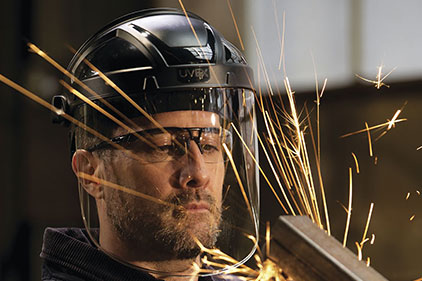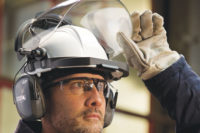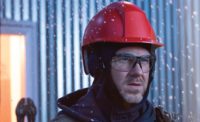Protecting workers from the neck up is exceptionally important to maintaining a healthy, productive and profitable workforce. This article looks at advances in personal protective equipment for the head and face as well as considerations for effective combination use and overall comfort. By understanding the evolving landscape of head protection offerings, safety managers can outfit the workforce with the most effective choices to improve compliance, reduce incidents and increase overall performance.
Hard hats
Hard hats are among the most commonly worn form of PPE in metal fabrication. Designed to resist penetration and absorb the shock of a blow, they protect workers from falling objects, bumps and electrical hazards. When it comes to selecting a cap, performance should be the number one consideration. The American National Standards Institute Z89.1-2009 standard for industrial head protection specifies two levels of protection. ANSI Type I hats are intended to protect the wearer against impact to and penetration of the crown, or top of head only, while ANSI Type II hats protect against both lateral and crown impact. While Type I hats are most widely used in the U.S., adoption of Type II hats is rapidly growing as employers recognize their lifesaving benefits. Evaluate your site’s hazards to determine the right type of protection; if any possibility of side impact exists, Type II hats should be considered.
Next to protection, wearer comfort is the second most important feature of a hard hat. Workers often need to wear their hats for a full eight-hour shift, and the more comfortable the hat is, the better the chances that they’ll wear it without interruption. To ensure comfort, take into account the hat’s number of suspension points, the suspension material and headband options. The more suspension points, the greater the comfort and the ability to disperse energy on impact. To ensure a safe fit, hats must be worn as snugly as possible, so consider sizing and adjustability options as well. Sizing is most popularly adjusted by pin locks or ratchets, though newer options such as sliding bands make resizing the cap quicker and easier than ever before. Likewise, if the cap will require frequent resizing, look for adjustability features that are extremely fast and easy to use, so workers spend less time making adjustments and more time focusing on the task at hand.
Combining PPE
Given the variety of hazards fabricators face, it is common for more than one type of PPE to be worn on the head at a time. Hard hats typically serve as the foundation while other types of PPE — face shields, welding helmets and vision and hearing protection — either attach to it or are worn in conjunction with it.
The most important consideration in combination use is selecting types of PPE that are easy to attach or interchange, comfortable to wear together and maintain safety standards when worn in tandem.
Any welding helmet or face shield used with a hard hat relies on some form of mounting system that attaches to the cap. Considerations for selecting a mounting system include frequency of use, ease of use, durability, flexibility and compatibility with different products. For high frequency situations, look for attachment systems that are fully adjustable to fit a wide variety of manufacturers’ hard hats and feature a brim tab design that fits securely onto the hat. For long-term secure situations, look for attachment components that are pre-installed and permanently fixed onto the hard hat for ease of use.
Face protection
The most underutilized above-the-shoulder PPE in metal fabrication is the face shield. Eye protection alone is not sufficient to protect the face and neck from harmful light, intense heat and airborne debris. Anyone conducting grinding, torch cutting or similar functions must also employ a face shield. When selecting a face shield, look for a versatile system that can attach to various brands of hard hats, has easy-to-use attachment features, offers extended coverage to protect the neck and ears, and comes in window shades appropriate for the application. Finally, because operations are often conducted in high heat environments, a face shield visor treated with an effective anti-fog coating will prolong safe, clear visibility.
Welding protection
Welding operations are widespread and pose significant risk to unprotected workers. In fact, individuals engaged in welding, soldering, cutting and brazing activities make up the second-highest occupation group to experience eye injuries, according to the BLS. Whenever such operations are conducted, a welding helmet should be worn to protect from burns caused by infrared or intense radiant light as well as from flying sparks, metal spatter and slag chips.
In use for more than 100 years, passive helmets utilize a shaded piece of glass or polycarbonate that the welder looks through. Because the filter is so dark, the welder must repeatedly raise the helmet to prepare the weld and then replace it before welding begins. In contrast, auto-darkening filters (ADF) automatically darken when the welding arc is struck, but when not activated remain light enough to see through easily. This allows for greater productivity and higher-quality welds, as well as a better overall ergonomic experience for the wearer. Advances in ADF helmets allow wider ranges of shaded protection for a consistently clear view of welds while eliminating the adjustments and strain involved in repeatedly lifting and nodding the helmet. By considering sleek and lightweight shell designs, workers benefit from superior comfort and increased productivity. And remember, anyone working near the arc flash should also be outfitted with an appropriate shade of eye protection.
Hearing protection
From grinding, hammering and cutting to disposing of metal objects, activities often expose workers to harmful levels of noise. Because prolonged exposure can lead to hearing loss, OSHA’s noise standard, 29 CFR 1910.95, requires the use of hearing protection when workers’ noise exposure exceeds an 8-hour time-weighted average sound level of 90 dBA. Options for hearing protection abound, and advances make it a more effective, convenient and comfortable form of PPE than ever before.
Since they are small and do not interfere with other types of PPE, ear plugs work in many applications. Recent advances allow ear plugs to feel more comfortable, provide higher levels of hearing protection and exert less pressure in the ear canal than traditional models. When work is conducted out-of-position or overhead, low-profile ear muffs are a versatile solution. The narrower cuff fits comfortably when worn in combination with head and face protection, and because ear muffs cover the ear, they also keep sparks or spatter from jumping into the ear canal. New styles featuring a band that sits behind the neck instead of over the head offer even greater comfort and ease of use during combination wear.
An occupational head injury can impair an individual for life or result in fatality. Outfitting workers with the appropriate forms of head and face protection can significantly reduce the risk of such injury. By understanding the types of PPE available, how to select safe and easy-to-use options for combination use and the key role comfort plays in compliance, safety managers can improve their organization’s safety record and contribute to their company’s overall culture of safety.


